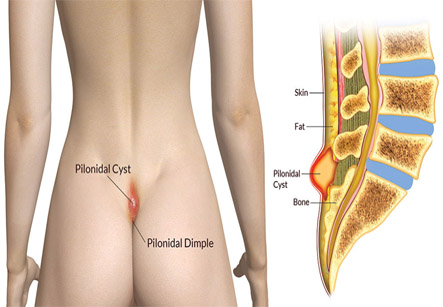Pilonidal Abscess
Introduction
The word “pilonidal” means “nest of hairs.” Basically, a pilonidal abscess is a name given to a large boil near the tailbone.
A pilonidal abscess occurs in the natal cleft, or commonly, the crack of the buttocks. The pilonidal is typically found near the tailbone. Pilonidal abscesses occur most frequently in men, but they can affect women also. Abscess means severe infection of the pilonidal sinus with pus formation in it.
Symptoms of Pilonidal Abscess
The first symptom of an infected pilonidal abscess is tenderness while sitting and walking. This tenderness may cause pain for a moment or it may be persistent type of pain. The pain associated with a pilonidal abscess may change in intensity depending on the position of the body.
A pilonidal sinus (PNS) is a small cyst or abscess that occurs in the cleft at the top of the buttocks. A PNS usually contains hair, dirt, and debris

Sometimes the pain only lasts for a day or so. If the pain starts increasing, there is a good chance that the pilonidal abscess is enlarging in size. The symptom which causes the most discomfort is when the abscess swells. When the pilonidal abscess swells, it fills up with a foul-smelling pus and blood. The swollen pilonidal abscess is very tender to touch and may prevent the patient from carrying out daily activities. When the pilonidal abscess has reached this point, medical attention is needed as soon as possible.
Prevention of Infected Pilonidal Abscess
There are various ways to prevent a pilonidal sinus from becoming infected. The most important prevention is maintenance of personal hygiene. Daily showers are a must for preventing a pilonidal sinus from becoming infected. Always wash the area thoroughly after washing hair and the rest of the body.
Some people are prone to having acne and boils on their buttocks. This problem can increase the chances of having an infected pilonidal abscess. Shampoos and conditioners with a high oil content may be a cause a for recurrent pilonidal abscesses. Shampoos and conditioners with less oil should be used to prevent infected pilonidal abscesses.
Pilonidal abscesses are generally caused by an ingrown hair which burrows deeper each time the pilonidal sinus becomes infected. A hair removal product can be of great help for preventing formation of a pilonidal abscess. Hair removal products should do the trick for removing the hairs from the area.
Treating an Infected Pilonidal Abscess
Due to the swelling and the presences of pus in the pilonidal abscess, drainage of pus should be the immediate course of action. Sometimes a pilonidal abscess may drain on its own, but most of them still need medical attention. The draining of a pilonidal abscess is performed usually by a general surgeon. The doctor applies a local anesthetic to numb the area of the pilonidal abscess, followed by a puncture. Sometimes the doctor may need to make an incision to allow the fluid to drain from the abscess. Following the procedure, the doctor usually prescribes a narcotic pain reliever. Following the procedure, the doctor checks the abscess every few days at the follow-up visit to make sure the abscess is healing and draining properly.
Pilonidal abscesses are generally caused by an ingrown hair which burrows deeper each time the pilonidal sinus becomes infected.
Even if the pilonidal abscess has been drained, antibiotics are usually prescribed by the surgeon. The antibiotic will kill the bacteria, such as E. coli, inside of the pilonidal abscess. Sometimes antibiotics are used alone, without puncturing, for treating pilonidal abscesses. Antibiotics are given for a period of ten days.
In some severe cases of recurring pilonidal abscesses, there is a need to remove the entire abscess by a procedure called as excision. This procedure normally performed as a day care surgery by a surgeon who specializes in these types of procedures. The excision can increase the chances of the pilonidal abscess to remain dormant, but only in a small percentage. Following the excision, about four to six weeks are required for the area to completely heal. Follow-up examinations are recommended to ensure proper healing of the area of pilonidal abscess.